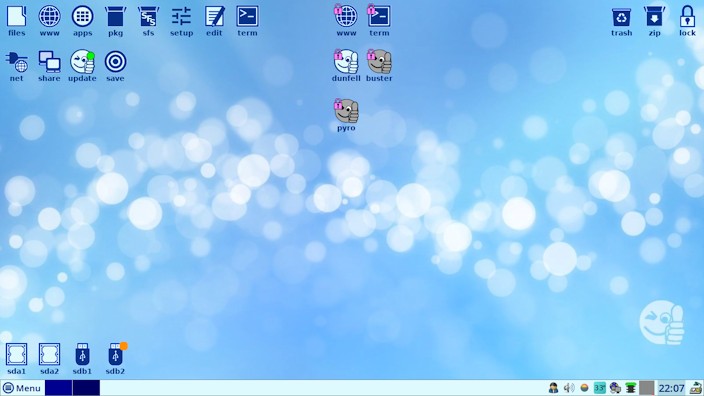EasyOS Dunfell-series version 4.0 released
The previous release was 3.4.7, on April 27, 2022:
https://bkhome.org/news/202204/easyos-version-347-released.html
Significant structural changes since then have warranted a major-version number bump, now 4.0.
Not a complete list, nor detailed, just some brief highlights of new features since 3.4.7, in no particular order:
- The download file is 'easy-4.0-amd64.img' -- no longer compressed, which simplifies writing the image to a drive.
- During normal usage, everything happens in RAM and there are no writes to the drive. This potentially means that a cheap flash stick (likely without wear-leveling) will last "forever".
- Squashfs files, including 'easy.sfs', are now lz4-hc compressed. This, in combination with running totally in RAM, results in noticeable speed improvements. App startup and container startup now very fast.
- There is now a "save" icon on the desktop. You choose when to
flush your work from RAM to drive, or not, or let it happen at
shutdown. Note, it is possible to flip back to the old mode,
direct writes to the drive, without a "save" icon.
- An old problem of unclean filesystem shutdown, due to the
layered filesystem on "/", has been solved.
- There has been a complete recompile in OpenEmbedded-Quirky,
designated as "revision-9".
More complete release notes here:
https://distro.ibiblio.org/easyos/amd64/releases/dunfell/2022/4.0/release-notes.htm
Here is a snapshot of the desktop, at 1366x768:

...the containers are top-middle. "www" runs Firefox, "term" runs a terminal, "dunfell" is Easy Dunfell 4.0 complete desktop running in a container. To test container creation, via "sfs" icon on the desktop, I created two more -- "buster" and "pyro" are older series of EasyOS, that will run as desktop in container.
Getting started with EasyOS is very simple. Download the .img file, write it to a USB flash-stick, then bootup from the flash-stick. If you need help how to write an image file to a drive, read this:
https://easyos.org/install/how-to-write-easyos-to-a-flash-drive.html
...however, if using 'dd' no longer any need to uncompress the image file. Just directly write it to the drive. For example, if the flash-stick is /dev/sdb:
# dd if=easy-4.0-amd64.img of=/dev/sdb bs=1M
# sync
Before doing that though, please be sure to use a good quality flash-stick. This blog post might help:
https://bkhome.org/news/202205/first-test-wd-elements-se-ssd-480gb-and-comparisons.html
Download
Download English, French and German builds, kindly hosted by ibiblio:
https://distro.ibiblio.org/easyos/amd64/releases/dunfell/2022/4.0/
Thanks to NLUUG, mirrored here:
https://ftp.nluug.nl/os/Linux/distr/easyos/amd64/releases/dunfell/2022/4.0/
To update an existing EasyOS, there is an "update" icon on the desktop. However, the script needs to be fixed, and I will post the working script to the forum (link below).
The update uses rsync; however, the rsync server at ibiblio.org has recently become flakey -- seemingly randomly disconnecting. So, you might be better off updating using the old method, as described here:
https://easyos.org/user/easy-version-upgrade-and-downgrade.html
...and fix the BOOT_SPECS file by clicking on 'initrd'. This is
preferred rather than kernel parameters.
More links
Feedback most welcome at the forum:
https://forum.puppylinux.com/viewtopic.php?t=6120
List of how and why EasyOS is different from other Linux distributions:
https://easyos.org/about/how-and-why-easyos-is-different.html
...to which we can now add extreme speed and flash-stick lasts
"forever" (not guaranteed of course).
Usage notes
Some little issues and buglets that we already know about:
- The de and fr builds do not have Bluegriffon WYSIWYG HTML editor.
- /etc/udev/rules.d/60-io-scheduler.rules should probably be removed, as the kernel incorrectly identifies usb flash-sticks as "rotational".
- HexChat, if run in a container, runs as "crippled root";
however there is a warning message not to run as root (OK on
main desktop, as runs as user 'hexchat').
- "apps" icon on desktop, "Graphic -> Diagram" button tries
to run Dia, which isn't installed.
Technical details
For the record, links to how EasyOS 4.0 was created. These might only interest Linux developers...
woofQ is the build-system that puts packages together and creates
EasyOS:
https://distro.ibiblio.org/easyos/project/woofq/2022/woof-project-20220607.tar.gz
Quirky is the OpenEmbedded build-system that compiles all of the
packages used in EasyOS:
https://distro.ibiblio.org/easyos/project/oe/dunfell/2022/dunfell-20220607.tar.gz
Source, patches and build scripts for the 5.15.44 kernel:
https://distro.ibiblio.org/easyos/source/kernel/5.15.x/5.15.44-20220531/
Have fun!
EDIT 2022-06-15:
Version 4.1 released:
https://bkhome.org/news/202206/easyos-dunfell-series-version-41-released.html
Tags: easy
